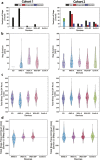Contactless and longitudinal monitoring of nocturnal sleep and daytime naps in older men and women: a digital health technology evaluation study
- PMID: 37471049
- PMCID: PMC10566241
- DOI: 10.1093/sleep/zsad194
Contactless and longitudinal monitoring of nocturnal sleep and daytime naps in older men and women: a digital health technology evaluation study
Abstract
Study objectives: To compare the 24-hour sleep assessment capabilities of two contactless sleep technologies (CSTs) to actigraphy in community-dwelling older adults.
Methods: We collected 7-14 days of data at home from 35 older adults (age: 65-83), some with medical conditions, using Withings Sleep Analyser (WSA, n = 29), Emfit QS (Emfit, n = 17), a standard actigraphy device (Actiwatch Spectrum [AWS, n = 34]), and a sleep diary (n = 35). We compared nocturnal and daytime sleep measures estimated by the CSTs and actigraphy without sleep diary information (AWS-A) against sleep-diary-assisted actigraphy (AWS|SD).
Results: Compared to sleep diary, both CSTs accurately determined the timing of nocturnal sleep (intraclass correlation [ICC]: going to bed, getting out of bed, time in bed >0.75), whereas the accuracy of AWS-A was much lower. Compared to AWS|SD, the CSTs overestimated nocturnal total sleep time (WSA: +92.71 ± 81.16 minutes; Emfit: +101.47 ± 75.95 minutes) as did AWS-A (+46.95 ± 67.26 minutes). The CSTs overestimated sleep efficiency (WSA: +9.19% ± 14.26%; Emfit: +9.41% ± 11.05%), whereas AWS-A estimate (-2.38% ± 10.06%) was accurate. About 65% (n = 23) of participants reported daytime naps either in bed or elsewhere. About 90% in-bed nap periods were accurately determined by WSA while Emfit was less accurate. All three devices estimated 24-hour sleep duration with an error of ≈10% compared to the sleep diary.
Conclusions: CSTs accurately capture the timing of in-bed nocturnal sleep periods without the need for sleep diary information. However, improvements are needed in assessing parameters such as total sleep time, sleep efficiency, and naps before these CSTs can be fully utilized in field settings.
Keywords: 24-hour sleep assessment; Actiwatch; Emfit QS; Withings Sleep Analyser; actigraphy; bed sensor; contactless sleep technologies; evaluation; home care; nearables; older adults; sleep; sleep diary.
© The Author(s) 2023. Published by Oxford University Press on behalf of Sleep Research Society.
Figures







Comment in
-
Contactless monitoring for the elderly: potential and pitfalls.Sleep. 2023 Oct 11;46(10):zsad227. doi: 10.1093/sleep/zsad227. Sleep. 2023. PMID: 37658741 Free PMC article. No abstract available.
References
-
- Winsky-Sommerer R, de Oliveira P, Loomis S, Wafford K, Dijk DJ, Gilmour G.. Disturbances of sleep quality, timing and structure and their relationship with other neuropsychiatric symptoms in Alzheimer’s disease and schizophrenia: insights from studies in patient populations and animal models. Neurosci Biobehav Rev. 2019;97:112–137. doi: 10.1016/j.neubiorev.2018.09.027 - DOI - PubMed
Grants and funding
LinkOut - more resources
Full Text Sources
Research Materials

